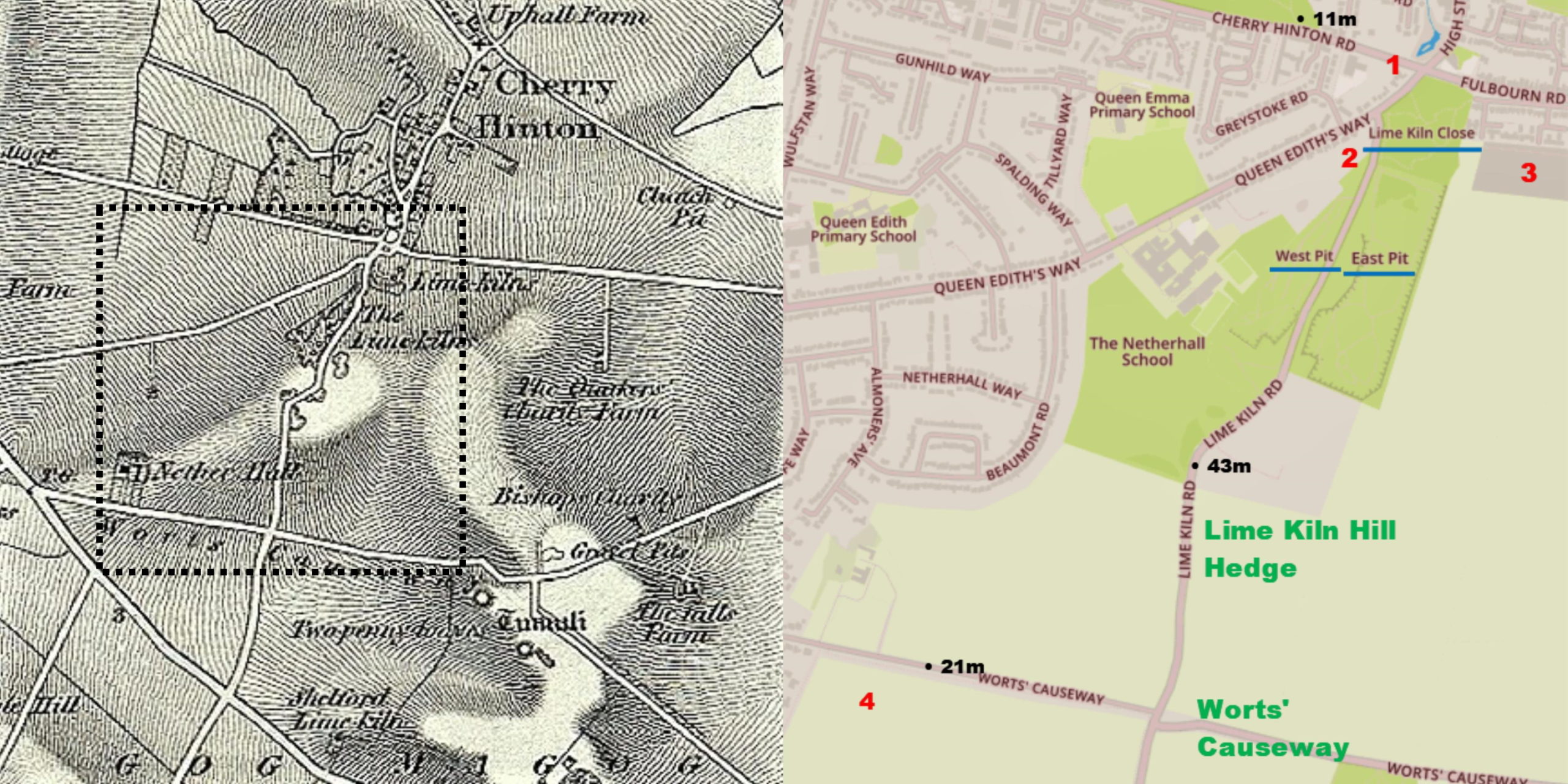Abstract
Lime Kiln Hill rises to 44m, the first high ground south-east of Cambridge centre. It consists of Chalk, above Totternhoe Stone & West Melbury Marl. It has 3 reserves: Lime Kiln Close, East and West Pits. It is crossed by Lime Kiln Road which meets Worts' Causeway to the south beyond which are the Gog Magog Hills. With one of the country's longest historical botanical records it is subject to creeping urbanisation. While joining BSBI @BSBIbotany & @WildFlowerHour on Twitter I have tried to keep track of its remarkable array of botanical rarities, and of urban encroachment, in photos.

Cherry Hinton village 3 miles (4.8km) from Great St Mary’s church in the centre of Cambridge must have seemed remote when Charles Babington came up to the University in 1827, where he remained for the rest of his life, becoming professor of botany and publishing his Flora (Babington, 1860). He makes several references to ‘Chalk Pit Close, Hinton’ and ‘between Hinton and the Gogmagog Hills’. The village has now become a suburb of the city. Living within walking distance I have been able, even under recent circumstances, to photograph local botanical specialties in nature reserves and hedges & verges, and to watch as urban development encroaches.

The Reserves
Lime Kiln Close
This tiny reserve (0.85ha) has a long history. Babington records that Israel Lyons found Perfoliate Honeysuckle in the vicinity before 1763. A Dipsacus specimen collected by Henslow at ‘Hinton’ in 1828 has been identified as Yellow-flowered Teasel (Leslie, 2019). Both of these still grow here. Babington also records Wild Liquorice from ‘Chalk-pit-close, Hinton’ which flowers close to the Wild Cherry trees reputed to have added ‘Cherry’ to the village name.

East Pit
In Babington’s time there were only a few small excavations where now a large chalkpit exists of about 7.6ha managed as a reserve by BCN Wildlife Trust. Reprofiling of the pit floor has exposed a broken chalk surface beneficial to many lime-loving flowering plants. Here are examples of Common Centaury, Field Madder, Hound’s-tongue, Lesser Swinecress & Yellow-wort.

West Pit
Above a caravan park in this old chalk pit is a Local Nature Reserve including a 0.25ha fragment of chalk downland reaching a height of 44m. Remarkably it supports small populations of Autumn Gentian, Bee Orchid, Great Pig-nut, Moon Carrot & Perennial Flax. Moon Carrot also grows on the dangerous verge outside the reserve amidst a collection of traffic debris. Although Babington’s reports for the area have Autumn Gentian only from Lime Kiln Close he knew all the others from the area of this reserve or the adjacent road which would have been devoid of today’s heavy traffic.

Verges & Hedges
Lime Kiln Road
This road fits well Babington’s description of ‘between Hinton and the Gogmagog Hills’. Beneath its eastern hedge and along the edge of an arable field is a population of true Grape Hyacinth (Muscari neglectum) where Babington reported collecting it on 11th April 1828. Although still present it is rapidly overwhelmed by Alexanders later in the season, a plant which Babington found locally only at the back of Lime Kiln Close.

Worts’ Causeway
In 1709 a William Wort financed the construction of this new road, finished in 1733 (Victoria County History) hence Worts’ Causeway. Recent realignment at its cross-roads with Lime Kiln Road has involved the creation of an earth bank. Although the verges are protected for native plants importing soil for the bank has led to the introduction of garden escapes such as: Daffodil, Pheasant’s-eye, Forsythia, Netted Iris, Sweet Cicely, Periwinkle & Glory of the Snow. It is unfortunate that the adjacent protected verge is mown early in the season and there is also evidence of the use of herbicide around the base of street signs.

Daffodil cultivar (Narcissus pseudonarcissus), Pheasant’s-eye (Narcissus poeticus), Forsythia (Forsythia x intermedia), Netted Iris (Iris reticulata),
Sweet Cicely (Myrrhis odorata), Periwinkle (Vinca major) & Glory of the Snow (Scilla forbesii),
plus evidence of the use of herbicide around the base of a street sign.
Development
1: Cherry Hinton corner is a small development where Lime Kiln Road meets Cherry Hinton Road. Previously the site was screened by a tall Laurel hedge beneath which unseasonal flowering could be guaranteed for BSBI New Year Plant Hunt such as garden escape Honesty which, for the moment, still persists.
2: Chalk Glade is another small development in an ancient chalk pit on the opposite side of Lime Kiln Road from the Close. When wire fencing was erected around the site it was promptly colonised by Perfoliate Honeysuckle suggesting that some of the rarities known to Babington had still been present on the site.
3: Peterhouse Technology Park has grown from the the old water-softening station converted for use by Acorn Computers
in 1981 as its headquarters (later to become ARM) and has continued to expand.
4: Newbury Farm development is a proposed development of 230 houses on a block of land already housing a park and ride, which is at the western foot of the Gog Magog hills.

Conclusion
Although the management of the three nature reserves on Lime Kiln Hill has well conserved the historic chalkland flora, this cannot be said for the road verges were imported and invasive species are taking a hold.
No doubt Babington would be astonished at the extent of the modern city right up to its foot of Lime Kiln Hill and now approaching Gog Magog as well, but also by the modern extent of East and West pit even though they are disused. The good management of the reserves does a lot to balance the decline in the road verges and hedges.
We must do everything possible to ensure that this hill remains as a haven for botanical rarities over the next 150 years.
References:
Babington, C.C. (1860) Flora of Cambridgeshire, John van Voorst, London.
Leslie, A.C. (2019) Flora of Cambridgeshire, RHS London.
Victoria County History, ‘Cherry Hinton’, A History of the County of Cambridge and the Isle of Ely, 2002. 10, 106-109. London.
* OS map: “This work is based on data provided through www.VisionofBritain.org.uk and uses historical material which is copyright of the Great Britain Historical GIS Project and the University of Portsmouth”.
